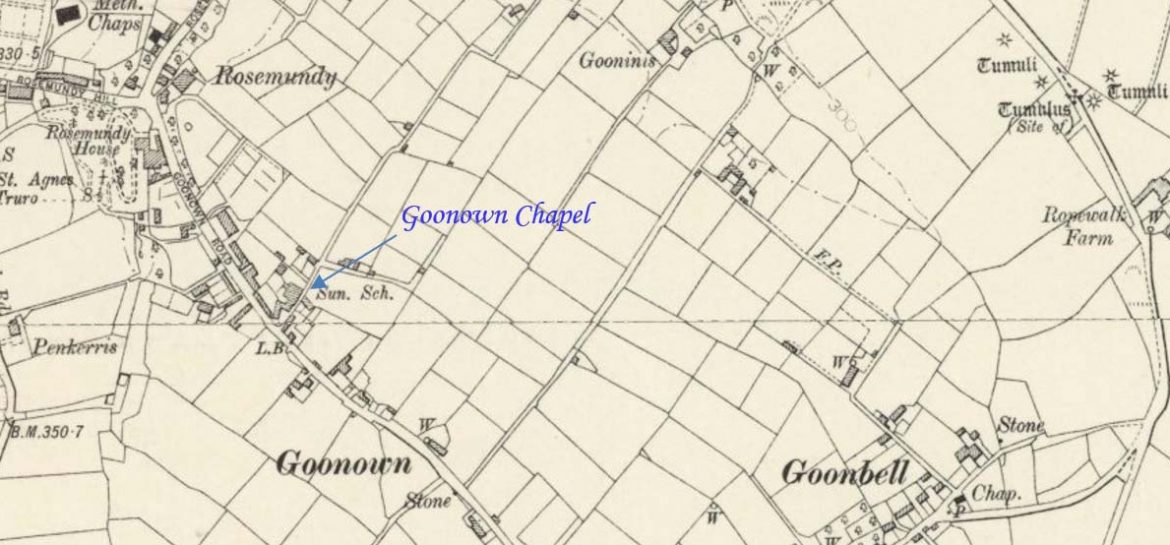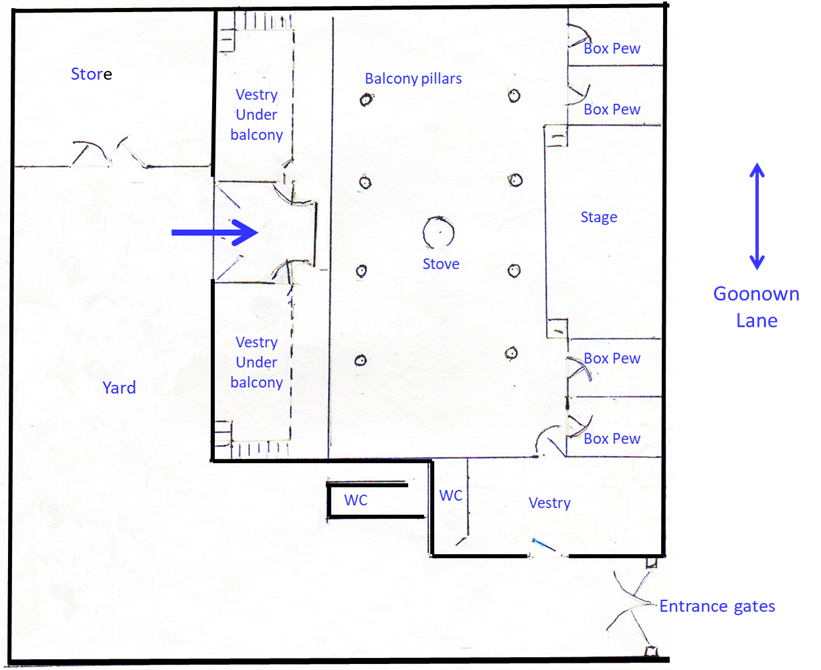
Goonown is an area near St Agnes village. This profile of Goonown Wesleyan chapel has been compiled by Clive Benney & Tony Mansell.
1790: Goonown Chapel was erected (flyleaf of the Goonown Chapel Trust Account Book of 1838). The date is crossed through and “or 1785” added in different handwriting and ink. R Symons of Truro, records circuit information and indicated that the amendment was made in 1863. The correct date is important. Tradition has it that John Wesley preached in this Chapel on his nineteenth and last visit to St Agnes in 1785. He wrote in his journal: “At half-past eight I preached at St Agnes to the largest congregation I ever saw there,” but it is quite clear that if the Chapel were built in 1790 he could not have preached there. Could it be that the date 1790 was altered on the account book cover to make the dates fit? Or was it because it was known at the time that John Wesley did preach there and therefore the original date of 1790 was wrong? We may never know, but it is quite possible that the great preacher did speak at Goonown Chapel.
1785 or 1790: Build date.
The chapel was located at the western end of Goonown Lane and was 75 ft. long by 66 ft. wide. Together with the gallery it had a seating capacity of approximately 300 people.
The floor was a mixture of lime, ash and sand and a notice in the porch read, “Ladies, please remove your pattens before coming into Chapel.” This was very necessary to avoid the floor being broken up. (1964 Re-opening souvenir programme)
The chapel cost £500 to build and there were seventeen trustees.
1809: Methodist Sunday school formed. (Re-opening Souvenir 1964)
1834 – 6th July: “The total number of scholars recorded … was 111 boys and 84 girls attending Sunday school with 16 male teachers and 18 female teachers. (1964 Re-opening souvenir programme)
1838: The trustees were Stephen Dale, James Angwin, James Evans, James Prout, Samuel Pearce, Joseph Ninnis, Francis Rowe, Stephen Martin, Thomas Martin, James Stephens, Edward Woolcock, Richard Rowe, William Rowe, Thomas Gill, Thomas M Ninnis, Thomas Rowse and John Nancarrow. (Minute book of Goonown Chapel Trust at Kresen Kernow)
1839: John Julian of St Agnes baptised. He is considered one of the greatest ever authorities on hymns. His Dictionary of Hymnology, published in 1892, will long remain the standard book on the subject.
1834-1840: Records, Sunday School, St Agnes Wesleyan Sunday School, Goonown. Volume of miscellaneous Sunday School records including fines on teachers, 1838-1840, account of verses learnt by children and rewards, 1835-1838, boys’ attendance register, 1839, resolutions of teachers’ meetings, 9th February 1834 and girls’ attendance register, 1839. St Agnes Wesleyan Sunday School continued to meet in the old chapel at Goonown after the building of the new chapel in 1862. (Kresen Kernow MRN/776)
1851 – 1st November: Chapel registered for the solemnizing of marriages, and on Christmas Day 1852, Sol Paull James was presented with a Bible and hymn book on his marriage, it being the first solemnized in the Chapel. (1984 Re-opening Souvenir 1964)
1852: More space was needed and it was resolved that a new vestry be erected for accommodating the classes and the 1964 Re-opening souvenir programme states that the building was enlarged twice.
1856: A spring cart purchased from Josiah Tregelles; it cost eleven guineas and was for circuit use. For many years the Society owned a circuit horse and soon after purchasing one mare it was found that she was pregnant. In later years it was decided to hire a horse rather than have the bother of stabling and feeding their own.
1853: There was no organ but expenditure recorded for a serpent and repairs to a bass viol. (Maurice Bizley)
One of the largest items of expenditure was the purchase of tallow candles for lighting. Water was purchased at two shillings (10p) a year from a neighbouring well owner and the rent to the Duchy of Cornwall was set at two-pence. The cleaner had to be paid and he or she received £1 per annum while the doorkeeper (perhaps the caretaker) was paid £1.10s.
The Chapel at Goonown recorded as a large, plain building.
1857 – 1860: The Revd Peter Parsons was the Methodist minister – presumably the last at Goonown Chapel before the transfer to the new building in British Road. His wife was Amelia Opie, probably the daughter of Edward Opie of Harmony Cot, Trevellas.
1862: Services transferred to the new chapel in British Road.
1862: Ceased to be a Methodist chapel but continued to be the home of the Sunday school and increasingly referred to as Goonown Schoolroom.
1867 – August: At a trust meeting the chairman stated that two brothers named Oates, from Blackwater, had applied to use the vestry for a day school. Both these men later became headmasters at Blackwater Board School. It was resolved that they be allowed to use it on weekdays until 1869. The rent was set at two shillings and sixpence (12½p) per quarter.
1868 – May: The day-school opened. (1984 Re-opening Souvenir 1964)
1870 – October: First public meeting there following the re-establishment of the Band of Hope.
1873: Of the 1838 trustees, only Thomas Rowe, John Nancarrow and T B Ninnis remained. New appointments were: James Rogers, Henry Peters, Walter Letcher, Richard Stribley, Nicholas Langdon, Richard Rickard, George Tregellas, Joseph Tremewan, James Letcher, Joel Hooper, John Williams, William Butson, Thomas Stribley, Thomas Stephens, Robert M James, Thomas Carter and James Rogers (Jnr). (1964 Re-opening souvenir programme)
1888: “… there were 154 boys and 161 girls” [attending Sunday school]. (1964 Re-opening souvenir programme)
1903: “After having been renovated, this Sunday school, one of the oldest in England, was re-opened on Friday. Mr. A. A. Richards, of Camborne, preached in the afternoon, and public tea was well patronised. The evening meeting, presided over by Mr. Charles Bryant, of Camborne (an old scholar), was largely attended, and interesting and earnest addresses given by the Revs. W. Hodson Smith, and G. W. Thompson, and Mr. A. A. Richards. The Wesley choir, under Mr. J. Angwin, contributed choice selections of anthems. Generous support has been given by present members of the school, and also by those living in other parts of the country, and in lands beyond the seas.” (17th December 1903 West Briton)
Sir Edwin Durning Lawrence gave a donation of two guineas towards renovations. (“Royal Cornwall Gazette” 14th January 1904)
In the first half of the 20th century Goonown Sunday school remained the centre for many activities in the village’s religious and social life including harvest suppers, tea treats, concerts, pantomimes, bazaars and jumble sales. Frank Roberts recalled a bazaar in the 1930s when Captain Keast ran an indoor shooting range – with air pistols!
1932: Truro People’s Choir were the stars in a concert to raise money for Society funds.
Frank Roberts recalled being a member of the Sea Scouts. He said that they had to go out in the road and come running when the leader sounded the bugle.
1930s – late: Some youngsters asked if they could set up a badminton court and the Revd A G Payne led a team of workers in removing the stage and box pews to make room for it. Frank Roberts helped with the work but was “called up” before he had a chance to play on it.
A portable stage was constructed.
1939 circa: The Sunday school transferred to the new chapel in British Road.
1940 – October: Local builder Albert Reynolds cleared the building.
1943: The building was requisitioned for use as a billet for American forces. Margaret Davey remembers the hall being used by soldiers returning after Dunkirk and described many of the men as being in rags and tatters. She said that the inside of the building was left in a poor condition.
1948 – February: Camborne Town Band concert there. Pam Roberts was able to confirm the date; it was her second date with Frank. She said, “The first was the night before so it must have gone alright.” Frank asked if the band could play Slavonic Rhapsody, a particularly rousing piece of music. The conductor, Mr A W Parker, said that they would play it if the roof could stand it.
1949: The building was refurbished and became the home for the new badminton club. It was also used for social events and concerts.
“It was the biggest public hall in St Agnes; it had a balcony and could accommodate large audiences. The stage was stored in a room adjoining the hall and erected for each event. The gallery was eventually condemned.” (Colin Butson of Goonown)
 Feast Day in Goonown Schoolroom (Photo: courtesy Clive Benney)
Feast Day in Goonown Schoolroom (Photo: courtesy Clive Benney)
 A celebration in Goonown Schoolroom (Photo: courtesy Clive Benney)
A celebration in Goonown Schoolroom (Photo: courtesy Clive Benney)
1955: The 21st anniversary of the St Agnes and Perranporth Methodist Circuit was celebrated in the hall and a 28lb birthday cake was the centrepiece of the celebratory tea.
There are still a few people who remember the building as a Sunday school but most will probably recall it as a superb concert venue. Its use was not restricted to the Wesleyans; it was a community hall much used by many village associations. It is recalled with affection and it is probable that had it been more central to the village it would not have been lost to us.
1963: Goonown Schoolroom/Hall sold for £300. (1964 Re-opening souvenir programme)
1963: Norman Coad purchased the building, demolished part of it – the section bordering the lane – and converted the remainder into three dwellings. The metal entrance gates were sold to Ralph Butson who erected them at Goonown Farm.
 Goonown Schoolroom layout (Frank Roberts / Tony Mansell)
Goonown Schoolroom layout (Frank Roberts / Tony Mansell)
